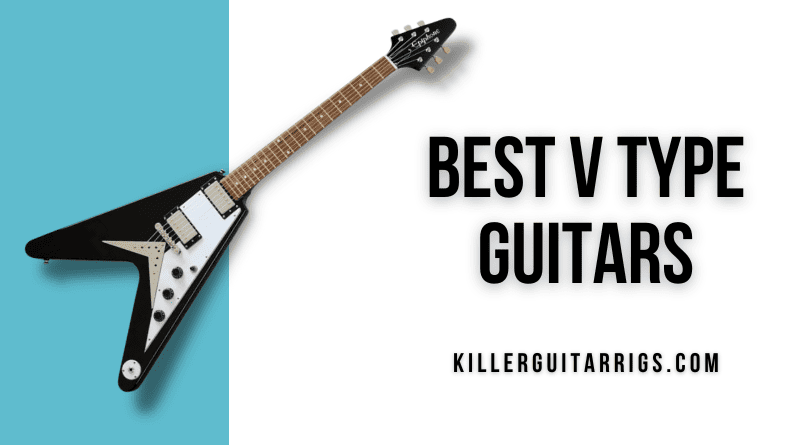Flying V-type guitars offer a range of great features like fat tone, good playability, and a retro contemporary look that’s really stood the test of time. Initially introduced by Gibson in 1958, the V style guitar didn’t become popular until blues master Albert King hit the scene using one in the ’60s.
Nowadays, plenty of brands offer V shaped guitars with all kinds of different features. The real challenge is making a decision on which one to buy.
In this KillerGuitarRigs Review, we’ll be showing you the best V-type guitars. During the review, we focused on tone, build quality, playability and overall features.
To ensure everything was covered on a level playing field, we used the same Fender Twin Amp as well as our Ibanez Tube Screamer and Electro Harmonix Big Muff Pi distortion pedals throughout each test. Keep on reading to learn more.
Read more about our review process.
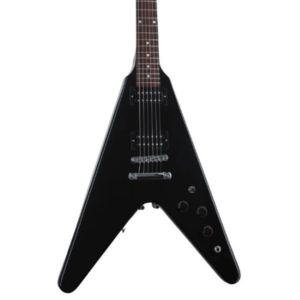
Gibson '80s Flying V
Features: Mahogany body, '80s Tribute humbuckers, Fitted hardshell case
Benefits: Searing tones, Ultra fast neck, Great tuning stability
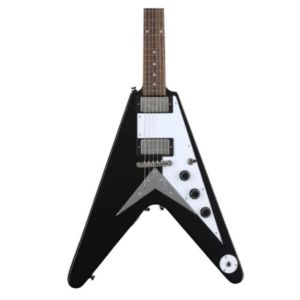
Epiphone Flying V Electric Guitar
Features: Slimtaper C neck, String through tailpiece, ProBucker pickups
Benefits: Vintage Flying V Feel, Fat tones, Incredible sustain
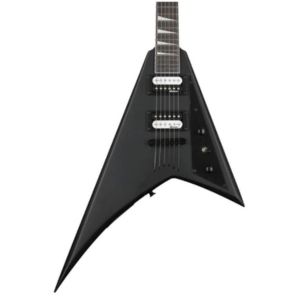
Jackson Rhoads JS32T
Features: Maple speed neck, 2 Ceramic humbuckers, Poplar body
Benefits: Aggressive aesthetics, Lightweight and comfortable, Super hot tones
Contents
Our Top 3
Our Top Pick was the Epiphone Flying V. With a resonant mahogany body, comfortable weight, and powerful humbucking sound from both the neck and bridge position, this guitar is a great choice for guitarists looking for an authentic Flying V at a great price.
Musicians looking for a good Flying V inspired guitar at a truly affordable price should check out our Best Budget option, the Jackson JS32T Rhoads. With a poplar body and its unique Rhoads body shape, this guitar was inspired by the legendary Randy Rhoads.
If you’re not worried about price, and quality is your main consideration, take a look at our Editor’s Choice, the Gibson ’80s Flying V. Considered by many to be one of the greatest metal guitars ever, it delivers a powerful growl and comes with great playability and a fast neck.
Individual Reviews
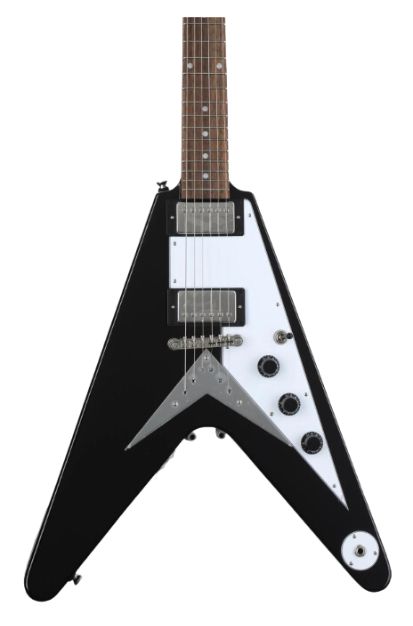
Epiphone Flying V
A classic made by Gibson's sister company.
The Epiphone Flying V offers the tone and feel of the original but at a much lower cost. This guitar comes from a company that has been under the Gibson umbrella for years and is the closest you will get to an authentic but affordable Flying V.
The Epiphone Flying V featured a mahogany body and weighed in at a comfortable 7.2 lb, which felt light and sturdy at the same time.
This Flying V came with ProBucker humbuckers made using Alnico II magnets, at both the bridge and neck positions. We started at the bridge and got a clear and present tone on clean, great for more forward accompaniment on open chords. Once we engaged some distortion from the pedalboard, we got a muscular tone that was penetrating but balanced, perfect for metal and rock.
For the neck pickup tests, we started with mild distortion and got a rounder tone that had a hint of a vintage PAF humbucker, thanks to the Alnico II magnets. When pushed further, we got an aggressive tone that was darker and great for power chord driven rhythm work.
This Epiphone gave us authentic Flying V playability thanks to its mahogany neck and SlimTaper C profile. We found the neck to be exceptionally comfortable and liked how the Indian laurel fingerboard felt, as well as the typical Gibson scale length of 24.75″ which gave a familiar feel for Gibson enthusiasts like us.
With other useful features like a LockTone Tune-o-Matic bridge, string-thru tailpiece, and Epiphone’s Vintage Deluxe 18:1-ratio tuners, we got a fantastic playing experience and tone with this Flying V.
Verdict: The Epiphone Flying V gives the guitarist an authentic Flying V tone and feel at a fraction of the cost. With a muscular tone on two humbuckers, a Gibson-type neck, and great playability, this guitar is a solid choice for players wanting the powerful tone and unique look of a flying V at a more palatable price.

Jackson Rhoads JS32T
A stylized version of a classic, with the touch of a legend.
Jackson and legendary guitarist Randy Rhoads teamed up to create not only a series of instruments but a unique guitar shape. With two hot humbuckers and a fast neck, this guitar features killer looks and still looks modern after decades of production.
The Jackson JS32T Rhoads solid-body electric guitar featured a poplar body that was lightweight and also helped to keep it affordable. Naturally, it came with a unique Rhoads body shape that matches the ferocious vibe of the master who inspired this instrument.
We started tone tests in the neck position, where we got a nice growly tone when we applied heavier distortion. We especially liked it with the tone knob at about the halfway point. Played clean, this pickup delivered a darker sound that still worked well with a reverb pedal.
Moving on to the bridge pickup, we got a high output and muscular distortion that was a bit more on the bright side, perfect for metal and heavy rock. We felt that the bridge pickup gave us the best results for heavy riffing, power chords that cut through, and solos with good sustain.
Regarding playability, we felt the Jackson JS32T Rhoads was quite comfortable when we considered its budget price. We liked how the 12″-16″ compound radius fretboard felt, as well as the Amaranth fingerboard. This guitar came with 24 jumbo frets and pearloid shark fin position inlays, which further added to the killer look.
Verdict: The Jackson JS32T Rhoads is a fantastic buy for guitarists seeking a metal and rock tone on a distinctive solid-body electric guitar. Lightweight and affordable, this guitar is ideal for beginners to more experienced intermediate players who have an appreciation for the greatness of Randy Rhoads or simply want a good guitar for high-gain styles music.
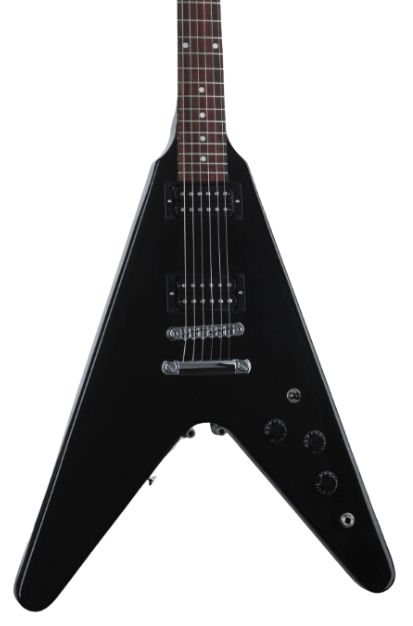
Gibson '80s Flying V
The ultimate Flying V for discerning players.
This is the ultimate, the original, and the standard against which all Flying V guitars are measured. This particular model is based on examples from what is arguably Metal’s most influential decade, and a great choice for those who have the budget for something a little more high end.
The Gibson ’80s Flying V has become one of the most iconic guitar types that defined an era. We were super excited to try this particular model, as the Flying V is considered by many to be one of the greatest metal guitars ever.
We absolutely loved this guitar’s playability. It had a nice, responsive rosewood fingerboard and we really enjoyed the mahogany neck with its Slim Taper profile. We were able to play fast runs comfortably and loved the overall feel of this authentic Gibson neck. With a 24.75″ scale length and nut width of 1.695″, it was substantial, but still slim enough to get up and down quickly.
It was fitted with a pair of Gibson ’80s Tribute Humbuckers and we thought they were really exceptional pickups. In the bridge position, we got gnarly distorted tones that were fantastic for metal. Whether playing lead or rhythm, we loved not only the aggression but also the responsiveness.
Moving on to the neck pickup, we got a tight low end with a darker quality, but that same aggressive response was still there. The neck pickup was excellent for clean tones, as it gave us a more balanced and warmer sound than the bridge pickup.
For distorted sounds, the neck pickup gave us a rounder tone that was still aggressive but with a darker quality. We loved it on everything from power chords to leads and beyond.
We thought the out-of-the-box setup was excellent, with accurate intonation and a really nice, low action. Tuning stability was great, no doubt influenced by the always fantastic Grover Mini Rotomatic tuners.
Verdict: The Gibson ’80s Flying V is one of our favorite versions of one of the most iconic guitars in history. With powerful humbucker pickups that deliver tons of crunch, massive sustain, and fantastic playability, it’s an ideal option for discerning players with a healthy budget.
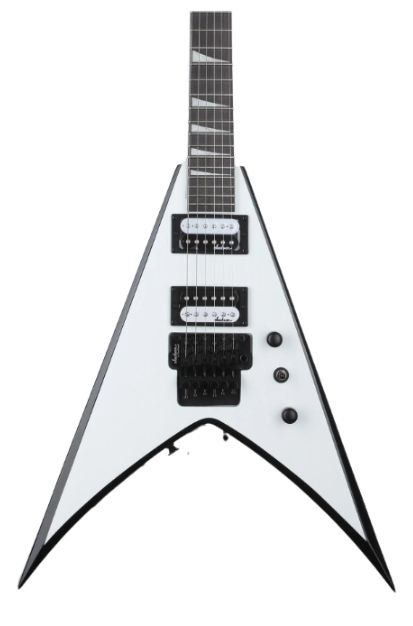
Jackson JS Series King V JS32
A contemporary and stylish take on the Flying V.
Jackson has a stellar reputation for building great instruments for metal music, and the King V JS32 is a great example of that tradition. This guitar delivers a fierce tone on both of its high output humbuckers and killer looks to match.
The Jackson JS Series King V JS32 featured a pair of custom-built humbuckers made for delivering high output punch for styles that require aggressive distortion.
We started with the bridge pickup, where we dialed up an aggressive distortion setting on our pedal and got a powerful but clear tone with a fat bottom end. Playing a few of the heaviest riffs we know in drop D tuning, the JS Series King V JS32 sounded great. We also liked it with a bit of delay and reverb, for killer leads that had nice sustain.
The bridge pickup gave us a punchy tone that was also good for riffs and power chords, but with a rounder character and not quite as bright as the neck pickup. We liked how it sounded with varying levels of distortion, however we found the clean tone lacked definition and became a tad muddy on the lower end.
Comfort was something this guitar had in spades. The Jackson JS32 King V came with a compound radius to make the switch between lead and rhythm really smooth, plus a super slim, comfy neck. We also liked the feel of the jumbo frets and comfortable Fender-like scale length of 25.5″. The factory setup was good and the tuning stability and intonation were both accurate and reliable.
It came with a Jackson Licensed Floyd Rose Double Locking Tremolo, which helped it retain its tuning well, even with heavy trem use, and gave us a nice range of expression when we pressed down on the whammy bar.
Verdict: The Jackson JS Series King V JS32 delivers nice playability with a fast neck and is ideal for metal players who want to perform fast runs. This guitar also delivers punchy and high output tones thanks to its custom-made Jackson humbuckers.
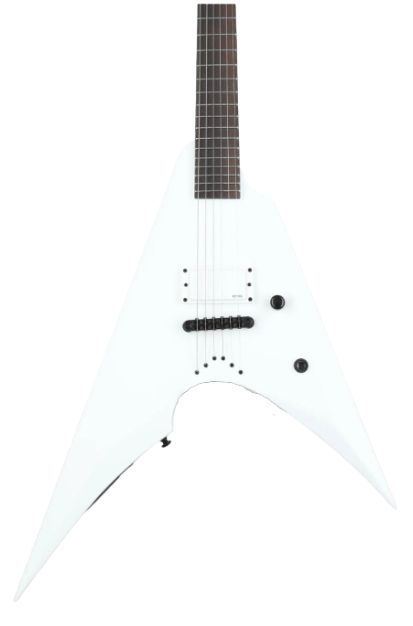
ESP LTD Arrow NT Arctic Metal
Modern growl with an active EMG pickup.
If you are looking for a modern version of the Flying V, the LTD Arrow NT is a fantastic choice. With a single pickup that brings the best of EMG's famed 81 model, this guitar features a unique design and aggressive tone for metal guitarists.
The ESP LTD Arrow NT Arctic Metal featured a solid mahogany body and a 3-piece maple neck with Macassar ebony fingerboard. This guitar came with Jackson’s unique asymmetric headstock and a highly stylized take on the classic Flying V body.
Although it only had one pickup, this Jackson is a versatile guitar thanks to the EMG 81TW, which gave us a variety of tonal options. This unique pickup uses dual internal preamps and we started our test with the single-coil mode via the push/pull coil-split button.
We got a tone that was powerful, but still had that bite single-coils are known for. We loved how it sounded with heavy distortion, delivering a penetrating mid voice that gave our power chords and riffs the character of a single coil, but with a much stronger output.
Switching to dual-coil mode, we got the fat humbucker growl that the EMG 81 is revered for. We loved this humbucker sound, as it gave us a punchy low end and muscular distortion with great sustain, especially for single lines. Played clean, we preferred the humbucker tone, as it was punchier and had a better frequency response.
Regarding playability, we really liked how this Jackson felt in our hands. We felt that the radius of 13.7″, along with the 24 stainless steel extra-jumbo frets, allowed us to play our fast runs comfortably.
Verdict: The ESP LTD Arrow NT Arctic Metal delivers a fast playing experience thanks to its comfortable maple neck and great tone with a versatile EMG active pickup that offers two modes of operation. With a unique look, this guitar is a good choice for guitarists who need high-output distortion for styles like metal and hard rock.
How to Choose the Right V for You
Flying V shaped guitars are usually employed for fast and aggressive styles of music. Two of the most important factors are playability and the pickups used. Naturally, the tonewoods used also make a difference. Below, we’ve touched on these considerations.
Playability
One of the most important aspects to consider when buying a V-shaped guitar is playability. As these guitars are usually employed for metal and other subgenres of rock that require fast playing, comfort on the neck is important.
Neck Shape
The neck profile or shape significantly affects how the guitar feels in your hand. There are various neck profiles, including C-shaped, U-shaped, V-shaped, and modern slim profiles. The best neck shape for playability depends on your hand size, playing technique, and comfort.
Neck Width
The width of the neck also plays a role in playability. A narrower neck may be more suitable for players with smaller hands or those who prefer faster playing. Thinner necks can be more comfortable for extended playing sessions. However, some players with larger hands or those who prefer a more substantial feel might prefer wider and thicker necks.
Radius
The fretboard radius refers to the curvature of the fretboard surface. Different radius sizes, such as 7.25″, 9.5″, 12″, and compound radius (which changes from a smaller radius at the nut to a larger radius at the higher frets) offer different playing experiences. A smaller radius means a more curved fretboard, making it easier to perform bends and chords, while a larger one offers a flatter surface for easier string bending and lower action.
Fret Size
The size and height of the frets can affect playability. Tall and narrow frets can provide a smooth feel and facilitate accurate intonation and bending. Vintage-style smaller frets might suit players who prefer a more vintage-style playing experience.
Towewoods
The tonewoods used on a V guitar will have an impact on the sound and feel. This is true for woods used for the body as well as the neck and fretboard. Below we’ve listed some common choices.
Alder
Alder is a popular choice for electric guitar bodies. It tends to produce a balanced and resonant tone with a slight emphasis on the midrange frequencies. Alder is known for its clarity, good sustain, and relatively lightweight feel, making it a common choice for many guitars.
Mahogany
Mahogany is a dense and heavy wood often used for guitar necks and bodies. It offers a warm, rich, and full-bodied tone with a strong emphasis on the lower frequencies when used on guitar bodies, giving the instrument a nice overall resonance. On top of that, mahogany can provide good sustain and a solid, substantial feel.
Maple
Maple is among the best and most popular tonewoods for guitars. It’s frequently used for guitar necks and sometimes for the guitar body as well. It offers a bright, clear, and articulate tone with enhanced upper midrange and high frequencies. Maple necks can contribute to a snappy and focused feel.
Rosewood
Rosewood is commonly used for guitar fingerboards. Although it isn’t typically used for the entire guitar body, this is the fretboard wood choice for many discerning musicians. Rosewood can contribute to a warm, smooth tone with well-defined lows and sparkling highs. It also provides a smooth and comfortable feel under the fingers.
Ebony
Ebony is another popular choice for guitar fingerboards. It is known for its dense and smooth surface, which contributes to a bright and articulate tone. Ebony fingerboards are very responsive and known for delivering excellent note definition and a sleek, fast-playing feel.
Poplar
Poplar is becoming increasingly popular for guitar bodies. This is because it’s an inexpensive tonewood that’s widely available. Another big advantage with Poplar is that it’s lightweight. However, the tradeoff is that guitars made with poplar don’t produce as much sustain as the tonewoods mentioned above.
Pickups
Figuring out whether you want single-coil or humbucking pickups is one of the most important decisions to make when shopping for your V guitar.
Humbucker pickups are commonly used for flying Vs. This is because, as opposed to single-coils, humbuckers provide a hotter output and more aggressive tone that’s less prone to noise. This makes it ideal for metal and other genres that rely on high gain distortion. When choosing your ideal flying V inspired guitar, take into account the humbucker pickups considering the following aspects.
While the majority of Flying V style guitars are equipped with humbuckers, there are still some with single-coils. Obviously single-coil pickups have a thinner, brighter sound than humbuckers.
Output
Humbuckers for flying Vs can vary in their output levels. Some humbuckers offer higher output, resulting in a more aggressive and powerful sound while others may have a lower output, offering a more vintage character.
Magnet Type
The type of magnets used in the humbucker construction can affect the pickup’s tonal characteristics. Alnico magnets (Alnico II, Alnico III, Alnico V) are commonly used and offer a warmer and smoother tone with more emphasis on the midrange. Ceramic magnets, on the other hand, tend to provide a brighter and more aggressive tone with an enhanced treble response.
Coil Splitting
Some Flying V models may feature wiring options like coil-splitting, which allows you to disable one coil of the humbucker to achieve a single-coil tone. This expands the tonal range of the pickup and provides more versatility.
Active Pickups
Some modern V shaped guitars feature active pickups instead of passive ones. Active pickups use a powered circuit or preamp to generate a signal. This results in higher output and higher gain, more distortion, and less background interference, all desirable items for genres like modern metal.
Final Thoughts
In this article we’ve given you 5 of the best Flying V inspired guitars on the market today. These run the gamut from affordable models all the way to pricier guitars with more professional features.
To recap our choices, our Top Pick was the Epiphone Flying V. With a warm-sounding mahogany body, light weight, and potent humbucking sound from both the neck and bridge position, this is a wonderful choice for guitarists in the market for an authentic Flying V at a great price.
Budget-conscious guitarists looking for a good V shaped guitar at an affordable price should check out our Best Budget option, the Jackson JS32T Rhoads. With a lightweight poplar body, this guitar was inspired by the legendary Randy Rhoads.
If you’re unworried about price and quality is your main concern, check out our Editor’s Choice, the Gibson ’80s Flying V. Believed by many to be one of the most renowned metal guitars ever, it delivers a full-bodied growl and comes with great playability and a fast neck.

